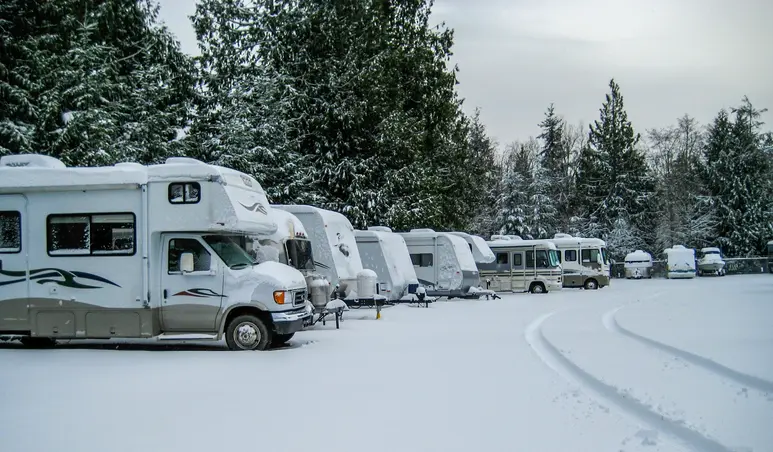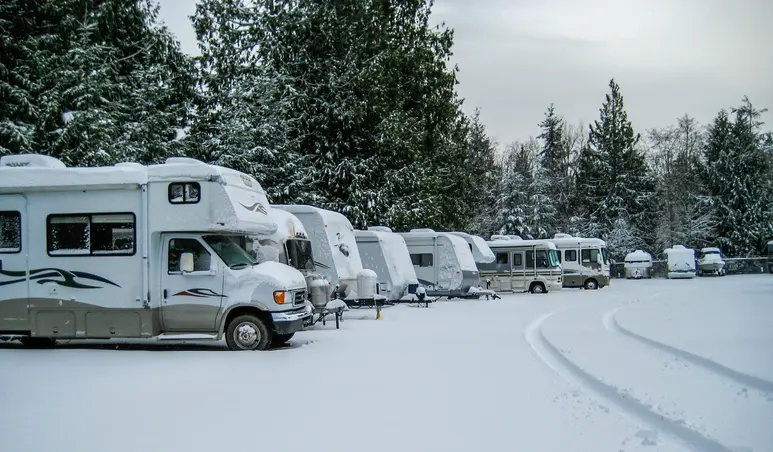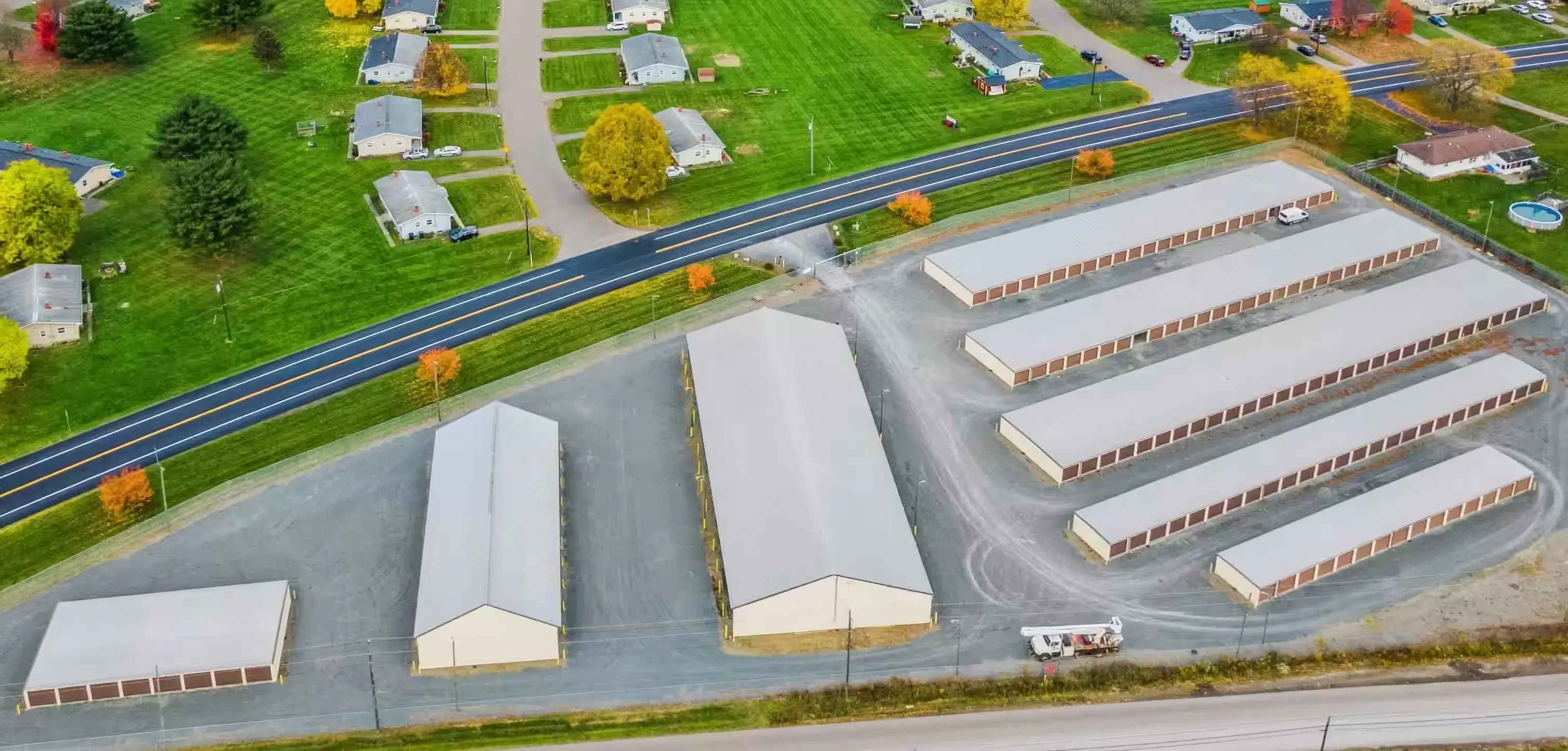Winterizing your RV is essential for protecting your investment and ensuring it's ready for future adventures. Harsh winter conditions while you've got your RV in storage, or parked, can cause significant damage to your RV’s plumbing, exterior, and interior if not properly prepared. By taking the time to winterize your RV, you can prevent costly repairs and extend the lifespan of your vehicle.
The winterization process involves several steps, from draining the water systems to protecting the exterior and interior of your RV. This guide will walk you through each step in detail, ensuring you have all the information you need to winterize your RV effectively. With proper preparation, you can store your RV safely and have it ready for use when the weather warms up again.
Start by Preparing for Winterization
Before you start the winterization process, it's important to gather all the necessary supplies. Having everything on hand will make the process smoother and more efficient.
Tools, Supplies and Packing List for Winterizing Your RV: Everything You Need
Tools and Equipment
- Wrench Set: For removing and tightening plumbing fittings and other components.
- Screwdriver Set: For accessing panels and securing various parts of the RV.
- Pliers: Useful for gripping and turning nuts, bolts, and other small components.
- Socket Set: For working on various mechanical parts.
- Water Pump Converter Kit: To facilitate the process of adding antifreeze to the plumbing system.
- Hand Pump: An alternative for adding antifreeze to the system if a converter kit is not available.
- Air Compressor: To blow out any remaining water from the plumbing lines.
- Jack Stands: To lift the RV and relieve pressure from the tires, preventing flat spots.
Cleaning Supplies
- Mild Detergent: For washing the exterior of the RV.
- RV Wax: To protect the exterior finish from the elements.
- Vacuum Cleaner: For cleaning carpets and upholstery inside the RV.
- Disinfectant Cleaner: For wiping down surfaces and appliances.
- Tank Cleaner: Specifically designed for cleaning and sanitizing black and gray water tanks.
Plumbing Supplies
- Non-Toxic RV Antifreeze: Specifically formulated for RV plumbing systems.
- Fresh Water Tank Cleaner: To clean and sanitize the fresh water tank before draining.
- Drain Plug Wrench: For removing the drain plug from the water heater.
- Water Heater Bypass Kit: To prevent antifreeze from entering the water heater.
- Flexible Hose: For connecting to the city water inlet when using an air compressor.
Sealants and Insulation
- Weather-Resistant Sealant: For sealing gaps around windows, doors, and other openings.
- Weatherstripping: To replace old or damaged weatherstripping around windows and doors.
- Foam Insulation Tape: For insulating vulnerable areas and pipes.
Moisture Control
- Moisture Absorbers (Silica Gel Packs, DampRid): To reduce humidity levels inside the RV.
- Portable Dehumidifier: For maintaining dry air inside the RV during storage.
Covers and Protective Gear
- RV Cover: To protect the exterior from snow, ice, and UV rays.
- Tire Covers: To prevent UV damage and cracking.
- Vent Covers: To allow for ventilation while keeping moisture and pests out.
- Protective Furniture Covers: To shield furniture and appliances from dust and condensation.
Battery Maintenance
- Battery Disconnect Switch: For safely disconnecting the battery to prevent drainage.
- Battery Trickle Charger: To maintain the battery charge during storage.
- Battery Terminal Cleaner: To clean corrosion from battery terminals.
Miscellaneous Items
- Flashlight: For inspections and work in low-light conditions.
- First Aid Kit: For any minor injuries that might occur during the process.
- Gloves: To protect your hands while working.
- Buckets and Rags: For various cleaning and maintenance tasks.
- Trash Bags: For disposing of waste and cleaning materials.
Having these supplies ready will ensure you can move through the winterization process without interruptions.
Draining the Water Systems
Water left in your RV's plumbing system can freeze and cause pipes to burst, leading to costly repairs. Draining all water from the system is a critical step in winterizing your RV.
Draining the Fresh Water System
Start by draining the fresh water system to ensure no water is left to freeze.
- Steps to Drain Fresh Water Tank: Open all faucets, including the kitchen sink, bathroom sink, shower, and any outdoor spigots. Locate the fresh water tank drain valve and open it to let the water flow out. Allow the tank to empty completely.
- Removing Residual Water: Use an air compressor to blow out any remaining water in the lines. Connect the air compressor to the city water inlet and open each faucet one by one until only air comes out. This step helps ensure that no water is left in the lines.
Draining the Water Heater
The water heater can retain a significant amount of water, so it’s important to drain it completely.
- Turning Off Power and Water Supply: Before draining the water heater, make sure to turn off the power supply to avoid damage. If your RV has an electric water heater, turn off the circuit breaker. For gas water heaters, turn off the gas supply.
- Draining and Bypassing the Water Heater: Open the pressure relief valve and the drain plug to allow the water to flow out. Use a wrench if necessary to remove the drain plug. Once drained, install a water heater bypass kit to prevent antifreeze from entering the water heater during the winterization process.
Draining the Holding Tanks
Properly draining and cleaning the black and gray water tanks is essential for winter storage.
- Emptying Black and Gray Water Tanks: Dump the contents of the black and gray water tanks at an appropriate disposal site. Make sure both tanks are completely empty.
- Cleaning and Sanitizing Tanks: After draining, clean and sanitize the tanks to prevent odors and buildup. Use a tank cleaner designed for RVs and follow the manufacturer's instructions. Flush the tanks with water to remove any remaining residue.
In the next section, we'll cover how to add antifreeze to your RV's plumbing system to protect it from freezing temperatures.
Adding Antifreeze to the Plumbing System
After draining the water systems, the next step is to add RV-specific antifreeze to protect your plumbing from freezing temperatures. This process ensures that any residual water in the pipes and fixtures will not freeze and cause damage.
Choosing the Right Antifreeze
Selecting the correct antifreeze is crucial for effective winterization.
- Types of Antifreeze Suitable for RVs: Use only non-toxic, RV-specific antifreeze. This type is safe for potable water systems and won’t harm your plumbing. Avoid automotive antifreeze, as it’s toxic and not suitable for RV use.
- Calculating the Amount Needed: The amount of antifreeze needed depends on the size of your RV and its plumbing system. Generally, 2-3 gallons of antifreeze should be sufficient, but larger RVs may require more. It's better to have extra on hand to ensure complete coverage.
Pumping Antifreeze Through the System
Pumping antifreeze through the plumbing system ensures it reaches all parts of the system, including pipes, faucets, and fixtures.
- Using the Water Pump to Distribute Antifreeze: Install a water pump converter kit or use a hand pump to add antifreeze to the system. Connect the antifreeze bottle to the water pump using the converter kit. Turn on the water pump and open each faucet one at a time, starting with the faucet closest to the pump. Run the faucet until pink antifreeze flows out, then close it and move to the next faucet.
- Ensuring Antifreeze Reaches All Faucets and Fixtures: Don’t forget to run antifreeze through the shower, toilet, and any exterior faucets. Flush the toilet until antifreeze enters the bowl. Pour a small amount of antifreeze down each drain, including the shower drain, to ensure P-traps are protected.
Protecting the Drains
Adding antifreeze to the drains and P-traps ensures these areas are protected from freezing as well.
- Adding Antifreeze to P-Traps and Toilets: Pour about a cup of antifreeze into each sink and shower drain. This ensures the P-traps, which hold a small amount of water to block sewer gases, are filled with antifreeze. Add antifreeze to the toilet bowl to protect the seal and prevent any remaining water from freezing.
With antifreeze properly distributed throughout your RV’s plumbing system, your pipes and fixtures will be protected from freezing temperatures. In the next section, we will cover exterior preparation to safeguard your RV’s outer surfaces from winter weather.
Exterior Preparation
Protecting the exterior of your RV from harsh winter weather is essential to prevent damage and ensure it remains in good condition. This section covers cleaning, inspecting, and sealing the exterior, as well as protecting the roof.
Cleaning and Inspecting the Exterior
Before sealing and covering your RV, it’s important to thoroughly clean and inspect the exterior.
- Washing and Waxing the RV: Start by giving your RV a good wash. Use a mild detergent and water to remove dirt, grime, and any road salt that could cause corrosion. Once clean, apply a coat of wax to protect the finish and create a barrier against the elements.
- Inspecting for Damage or Leaks: While washing your RV, inspect the exterior for any signs of damage or leaks. Look for cracks, holes, or gaps in the siding, roof, and around windows and doors. Pay close attention to seals and seams where water might penetrate.
Sealing Windows and Doors
Properly sealing your RV’s windows and doors helps prevent drafts and moisture from entering.
- Applying Sealant to Prevent Drafts: Use a high-quality, weather-resistant sealant to fill any gaps or cracks around windows, doors, and other openings. This helps to keep cold air out and warm air in, maintaining a stable interior temperature.
- Checking and Replacing Weatherstripping: Inspect the weatherstripping around windows and doors. If it’s cracked, brittle, or missing, replace it with new weatherstripping to ensure a tight seal.
Protecting the RV Roof
The roof is a critical area to protect, as it’s most exposed to snow, ice, and rain.
- Inspecting and Repairing the Roof: Thoroughly inspect the roof for any signs of damage, such as cracks, tears, or worn areas. Pay special attention to seams and seals around roof vents, air conditioning units, and other fixtures. Make necessary repairs using appropriate materials.
- Applying Roof Protectant: Apply a roof protectant specifically designed for RVs. This creates a protective barrier that helps prevent damage from UV rays, snow, and ice. Ensure the roof is clean and dry before applying the protectant for best results.
With the exterior cleaned, inspected, and protected, your RV is better equipped to handle winter weather. In the next section, we’ll focus on interior preparation, including cleaning, decluttering, and protecting interior surfaces.
Interior Preparation
Properly preparing the interior of your RV for winter storage ensures it remains clean, dry, and ready for use when the season changes. This section covers cleaning, decluttering, and protecting interior surfaces, as well as battery maintenance.
Cleaning and Decluttering
A clean and clutter-free interior prevents odors, pests, and damage during storage.
- Removing Perishables and Personal Items: Start by removing all perishable food items from your RV to prevent mold, mildew, and pests. Check all cabinets, the refrigerator, and pantry. Also, remove personal items and valuables to avoid damage or theft.
- Deep Cleaning the Interior: Perform a thorough cleaning of the entire interior. Vacuum carpets and upholstery, wipe down surfaces with a disinfectant cleaner, and clean all appliances. Pay special attention to the kitchen and bathroom areas, as these can harbor bacteria and odors.
Protecting Interior Surfaces
Protecting surfaces inside your RV helps prevent damage from moisture and cold temperatures.
- Using Moisture Absorbers and Dehumidifiers: Place moisture absorbers, such as silica gel packs or DampRid, throughout the RV to reduce humidity levels and prevent mold and mildew. If possible, use a small, portable dehumidifier to maintain dry air inside the RV.
- Covering Furniture and Appliances: Use protective covers for furniture and appliances to keep them dust-free and shielded from potential condensation. Covering helps maintain their condition and makes spring cleaning easier.
Battery Maintenance
Proper battery care ensures your RV’s electrical system remains functional and extends battery life.
- Disconnecting and Storing Batteries: Disconnect the RV’s main battery and any auxiliary batteries to prevent them from draining during storage. Store the batteries in a cool, dry place. If the storage area is subject to freezing temperatures, consider keeping the batteries indoors.
- Using a Trickle Charger: To maintain battery health, use a trickle charger. This device keeps the battery charged without overcharging it. Regularly check the battery charge and water levels (for lead-acid batteries) to ensure they remain in good condition.
With the interior cleaned, decluttered, and protected, your RV is well-prepared for winter storage. In the next section, we’ll discuss winter storage tips, including choosing the right storage location, implementing security measures, and conducting regular maintenance checks.
Winter Storage Tips
Proper RV storage is essential for maintaining your RV's condition throughout the winter months. This section covers selecting the right storage location, implementing security measures, and conducting regular maintenance checks.
PS: If you're looking for RV Storage near you, you can easily find a location near you.
Choosing the Right Storage Location
Selecting the best storage location for your RV can protect it from harsh winter conditions and potential damage.
- Indoor vs. Outdoor Storage: Indoor storage offers the most protection from the elements, keeping your RV safe from snow, ice, and UV damage. If indoor storage isn't available, consider covered storage as a compromise. Outdoor storage is the most affordable but offers the least protection. Ensure the location is secure and well-drained to prevent water accumulation around the RV.
- Benefits of Covered Storage: Covered storage protects your RV from direct exposure to snow, ice, and sun, reducing wear and tear on the exterior. It's a cost-effective alternative to indoor storage and provides a good balance of protection and affordability.
Security Measures
Ensuring your RV is secure during storage prevents theft and vandalism.
- Securing Doors and Windows: Lock all doors and windows securely. Consider installing additional locks or security bars for extra protection. Close and secure all vents and skylights to prevent unauthorized access.
- Using an RV Cover: Invest in a high-quality RV cover to protect your vehicle from the elements. Ensure the cover is breathable to prevent moisture buildup and fits snugly to avoid flapping in the wind. An RV cover can also deter potential thieves by obscuring the contents and making access more difficult.
Regular Maintenance Checks
Even while in storage, your RV requires regular checks to ensure it remains in good condition.
- Monthly Inspections: Perform monthly inspections to check for signs of leaks, pests, or damage. Open doors and windows periodically to air out the interior and prevent mold and mildew buildup. Check tire pressure and condition, and move the RV slightly to prevent flat spots.
- Addressing Any Issues Promptly: If you notice any problems during your inspections, address them immediately. Small issues can escalate if left unattended, leading to more significant and costly repairs.
With these storage tips, you can ensure your RV remains safe, secure, and in good condition throughout the winter. In the next section, we’ll discuss how to prepare your RV for use when winter is over, including reversing the winterization process and performing necessary mechanical checks.
Returning Your RV to Use after Winter
When winter is over, it's time to prepare your RV for use again. Whoop whoop, time for Summer adventures!
This section covers reversing the winterization process, performing mechanical checks, and cleaning and restocking your RV.
To get your RV ready for the road, you need to remove the antifreeze and reconnect all systems.
- Flushing Antifreeze from the System: Connect your RV to a clean water source. Open all faucets, including the kitchen sink, bathroom sink, shower, and any outdoor spigots. Run water through the system until it runs clear, flushing out the antifreeze. Don’t forget to flush the toilet and run water through the shower. Drain and refill the fresh water tank to ensure any residual antifreeze is removed.
- Reconnecting Water and Power: Reconnect the water heater bypass and fill the water heater. Turn on the water pump and check for leaks. If your RV has a water filtration system, replace the filter. Reconnect the RV’s main battery and any auxiliary batteries, ensuring they are fully charged.
Performing Mechanical Checks
Before you hit the road, it's crucial to ensure all mechanical systems are functioning correctly.
- Starting the Engine and Checking Fluids: Start the engine and let it run for a few minutes. Check all fluid levels, including oil, coolant, brake fluid, and transmission fluid. Top off any low fluids. Inspect the belts and hoses for signs of wear and replace them if necessary.
- Inspecting Tires and Brakes: Check the tire pressure and inflate tires to the recommended level. Inspect the tires for any signs of damage or wear, and make sure the lug nuts are tight. Test the brakes to ensure they are functioning properly and check the brake fluid level.
Cleaning and Restocking
A clean and well-stocked RV makes for a more enjoyable travel experience.
- Cleaning the Exterior and Interior: Give your RV a thorough cleaning inside and out. Wash the exterior to remove any dirt or grime that may have accumulated during storage. Clean the interior, paying special attention to areas that may have gathered dust or cobwebs. Vacuum the floors, wipe down surfaces, and clean the windows.
- Replenishing Supplies: Restock your RV with essential supplies, such as toiletries, kitchen items, and cleaning products. Check the expiration dates on any food items left in the RV and replace them as needed. Make sure you have all necessary tools and emergency supplies, such as a first aid kit, flashlight, and spare tire.
Winterizing your RV properly and preparing it for use again ensures your vehicle remains in excellent condition and ready for your next adventure. By following these detailed steps for draining water systems, adding antifreeze, protecting the exterior and interior, and conducting regular maintenance checks, you can protect your RV from harsh winter conditions. Additionally, reversing the winterization process carefully and performing necessary mechanical checks will help you hit the road with confidence.
Proper RV storage and winterization practices not only protect your investment but also enhance your travel experiences by ensuring your RV is always in top condition. Remember to keep detailed records, perform regular inspections, and address any issues promptly. Happy travels!
Bonus: Winterizing Your RV Checklist
Collect Your Supplies
Preparing for Winterization
- Remove Perishables and Personal Items:
- Clear out all food items from the refrigerator, pantry, and cabinets.
- Remove any personal belongings and valuables.
- Deep Clean the Interior:
- Vacuum carpets and upholstery.
- Wipe down surfaces with disinfectant cleaner.
- Clean all appliances thoroughly.
Draining the Water Systems
- Drain the Fresh Water System:
- Open all faucets (kitchen sink, bathroom sink, shower, outdoor spigots).
- Locate and open the fresh water tank drain valve.
- Use an air compressor to blow out residual water from the lines.
- Drain the Water Heater:
- Turn off the power supply (electric or gas).
- Open the pressure relief valve and remove the drain plug.
- Install a water heater bypass kit.
- Drain the Holding Tanks:
- Empty the black and gray water tanks at an appropriate disposal site.
- Clean and sanitize the tanks using a tank cleaner.
Adding Antifreeze to the Plumbing System
- Choose the Right Antifreeze:
- Ensure it is non-toxic and suitable for RVs.
- Calculate the amount needed (typically 2-3 gallons).
- Pump Antifreeze Through the System:
- Use the water pump converter kit or hand pump.
- Open each faucet one by one until pink antifreeze flows out.
- Flush the toilet and run water through the shower.
- Protect the Drains:
- Pour a cup of antifreeze into each sink and shower drain.
- Add antifreeze to the toilet bowl to protect the seal.
Exterior Preparation
- Clean and Inspect the Exterior:
- Wash the RV with mild detergent.
- Apply a coat of RV wax.
- Inspect for damage or leaks.
- Seal Windows and Doors:
- Apply weather-resistant sealant to gaps around windows and doors.
- Check and replace weatherstripping as needed.
- Protect the RV Roof:
- Inspect the roof for damage.
- Make necessary repairs.
- Apply a roof protectant.
Interior Preparation
- Clean and Declutter:
- Remove perishable items and personal belongings.
- Perform a deep clean of the interior.
- Protect Interior Surfaces:
- Use moisture absorbers or a portable dehumidifier.
- Cover furniture and appliances with protective covers.
- Battery Maintenance:
- Disconnect the main and auxiliary batteries.
- Store batteries in a cool, dry place.
- Use a trickle charger to maintain battery charge.
Winter Storage Tips
- Choose the Right Storage Location:
- Decide between indoor, covered, or outdoor storage.
- Ensure the location is secure and well-drained.
- Implement Security Measures:
- Lock all doors and windows securely.
- Install additional locks or security bars.
- Use a high-quality RV cover.
- Perform Regular Maintenance Checks:
- Conduct monthly inspections for leaks, pests, or damage.
- Open doors and windows periodically to air out the interior.
- Check tire pressure and condition.
Returning Your RV to Use
- Reverse the Winterization Process:
- Flush antifreeze from the system by running water through all faucets.
- Reconnect the water heater bypass and fill the water heater.
- Reconnect the main and auxiliary batteries.
- Perform Mechanical Checks:
- Start the engine and check fluid levels (oil, coolant, brake fluid, transmission fluid).
- Inspect belts and hoses.
- Check tire pressure and condition.
- Test the brakes.
- Clean and Restock:
- Wash the exterior and clean the interior.
- Restock essential supplies (toiletries, kitchen items, cleaning products).
- Replace any expired food items.
Find Storage Units Near You Up To 75% Off
Discover nearby storage units with up to 75% off at Bolt Storage. Affordable solutions for your storage needs. Find convenience without the high cost.
PRICE MATCH GUARANTEE
We will beat any price in town





.webp)
%2520(1).webp)

.webp)
